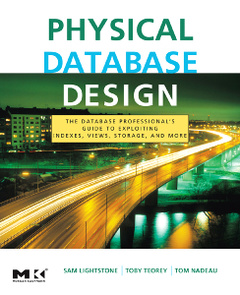Description
Physical Database Design
The Database Professional's Guide to Exploiting Indexes, Views, Storage, and More
The Morgan Kaufmann Series in Data Management Systems Series
Authors: Lightstone Sam S., Teorey Toby J., Nadeau Tom
Language: English
Subject for Physical Database Design:
448 p. · 19x23.3 cm · Paperback
Out of Print
Description
/li>Contents
/li>Readership
/li>Biography
/li>Comment
/li>
The rapidly increasing volume of information contained in relational databases places a strain on databases, performance, and maintainability: DBAs are under greater pressure than ever to optimize database structure for system performance and administration.
Physical Database Design discusses the concept of how physical structures of databases affect performance, including specific examples, guidelines, and best and worst practices for a variety of DBMSs and configurations. Something as simple as improving the table index design has a profound impact on performance. Every form of relational database, such as Online Transaction Processing (OLTP), Enterprise Resource Management (ERP), Data Mining (DM), or Management Resource Planning (MRP), can be improved using the methods provided in the book.
He is an IBM Master Inventor with over 25 patents and patents pending; he has published widely on autonomic computing for relational database systems. He has been with IBM since 1991.
Toby J. Teorey is a professor in the Electrical Engineering and Computer Science Department at the University of Michigan, Ann Arbor. He received his B.S. and M.S. degrees in electrical engineering from the University of Arizona, Tucson, and a Ph.D. in computer sciences from the University of Wisconsin, Madison. He was general chair of the 1981 ACM SIGMOD Conference and program chair for the 1991 Entity-Relationship Conference. Professor Teorey’s current research focuses on database design and data warehousing, OLAP, advanced database systems, and performance of computer networks. He is a member of the ACM and the IEEE Computer Society.
Tom Nadeau is the founder of Aladdin Software (aladdinsoftware.com) and works in the area of data and text mining. He received his B.S. degree in computer science and M.S. and Ph.D. degrees in electrical engineering and computer science from the University of Michigan, Ann Arbor. His technical interests include data warehousing, OLAP, data mining and machine learning. He won the best paper award at the 2001 IBM CASCON Conference.
- The first complete treatment on physical database design, written by the authors of the seminal, Database Modeling and Design: Logical Design, Fourth Edition
- Includes an introduction to the major concepts of physical database design as well as detailed examples, using methodologies and tools most popular for relational databases today: Oracle, DB2 (IBM), and SQL Server (Microsoft)
- Focuses on physical database design for exploiting B+tree indexing, clustered indexes, multidimensional clustering (MDC), range partitioning, shared nothing partitioning, shared disk data placement, materialized views, bitmap indexes, automated design tools, and more!




